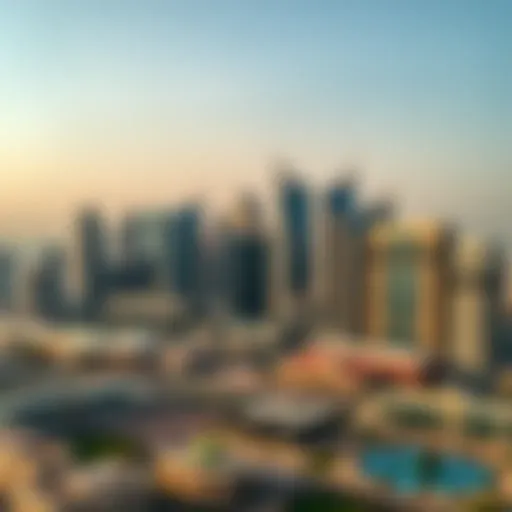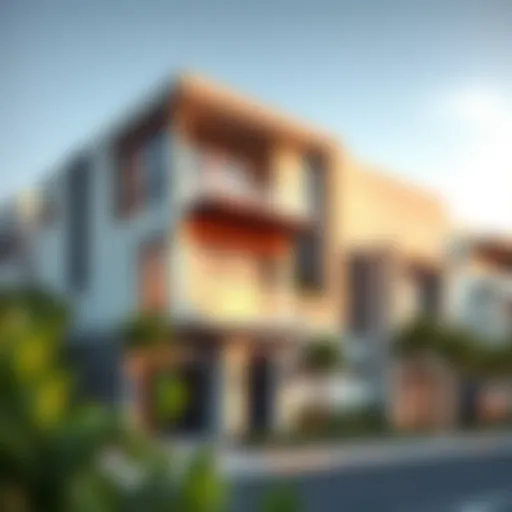The Influence of Dubai's Large Shopping Malls
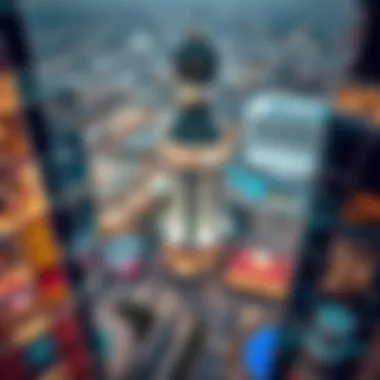

Intro
Dubai is often seen as a modern marvel, where luxury meets innovation in a desert landscape. The bustling shopping malls in this city are more than just retail spaces; they are cultural hubs that embody the spirit of the UAE. These large platforms attract not only the residents but also expats and tourists from around the globe, drawing millions to experience their unique offerings.
In recent years, large shopping malls have taken on a significant role within both the economy and the social dynamics of Dubai. Malls like The Dubai Mall and Mall of the Emirates exemplify this phenomenon through their extravagant designs, world-class amenities, and diverse retail offerings. The allure of high fashion, entertainment, and dining all come together here, creating an essential part of the city’s vibrancy.
As we delve deeper, this article will explore how these colossal shopping venues have evolved, catered to a variety of audiences, and shaped local culture. It will also look towards the future, examining market trends and investment opportunities, making it essential reading for investors, homeowners, and expatriates keen on navigating this dynamic landscape.
Market Trends and Insights
Current Market Overview
As of late 2023, the shopping mall industry in Dubai exhibits promising characteristics. With an influx of visitors and residents, the demand for retail and entertainment options remains robust. The large malls in Dubai are not just about shopping; they are entertainment ecosystems. Beyond retail, many malls incorporate attractions like indoor ski slopes, aquariums, and even art galleries. This gives them an edge, appealing to families, young adults, and tourists alike.
Consumer behavior has also shifted as online shopping has grown more prevalent. Malls are responding by enhancing their experiences through technology, offering seamless payment options and interactive marketing strategies. Moreover, sustainability is becoming a focus, with several establishments adopting eco-friendly practices, which also resonates well with the city’s progressive vision.
Future Predictions and Opportunities
Looking ahead, the future of shopping malls in Dubai appears bright, provided that they can adapt to continuous shifts in consumer expectations. Reports suggest that by 2025, further expansion is anticipated, with new malls scheduled to open. These new spaces are expected to feature innovative designs and concepts that address growing trends like mixed-use developments.
“The incorporation of technology like augmented reality in shopping experiences will likely redefine how consumers engage with retail spaces.”
Investors should also keep a keen eye on emerging neighborhoods where new commercial real estate options are popping up. Areas experiencing rapid development may offer lucrative opportunities for investment. By studying market insights and impending trends, stakeholders can position themselves effectively to capitalize on what the future brings.
Property Types and Listings
Luxury Apartments
Gearing up for the next wave of development, the property market surrounding these large malls is equally compelling. High-end apartments are flourishing, often designed with direct access to mall facilities. Areas like Downtown Dubai or Dubai Marina feature high-rise luxury apartments that attract affluent residents seeking both comfort and convenience. These real-estate offerings not only present a comfortable living environment but also a lifestyle that emphasizes accessibility to shopping and entertainment.
Commercial Real Estate Options
On the commercial front, opportunities abound as businesses look to capitalize on foot traffic generated by these malls. Potential investors should explore options ranging from retail slot leasing to establishing new dining avenues within or near malls. With advantageous lease terms and a thriving tourist and expat population, commercial spaces within or adjacent to large shopping malls carry a substantial return on investment.
Prologue to Dubai's Retail Landscape
When it comes to retail scenes, Dubai is a gem set in the vast desert. This city has carved its niche as a leading global shopping destination, with large shopping malls playing a pivotal role in this transformation. The contrasting blend of tradition and innovation is profoundly visible in the retail landscape of Dubai.
Dubai's malls are not just about shopping; they are cultural phenomena that reflect the city's essence. These hubs showcase the opulence and grandeur that Dubai is known for, attracting millions of visitors each year. Whether it's the extravagant displays in the Dubai Mall or the ski slopes at Mall of the Emirates, the offerings are varied and vibrant.
Why is understanding this topic essential?
- Economic Vitality: Large shopping malls contribute significantly to the local economy. They create jobs and stimulate various associated businesses. A healthy retail environment often signals a robust economy.
- Cultural Exchange: Dubai's shopping malls serve as melting pots of cultures. They attract people from different backgrounds, providing a unique space for social interaction. This diversity enriches the experience of both locals and visitors.
- Investment Opportunities: For investors and property seekers, understanding the dynamics of Dubai's retail landscape can unveil lucrative prospects in a market that is ever-evolving.
As we delve deeper into the historical context and key characteristics of these malls, it becomes evident that they are more than just structures filled with shops. They symbolize the broader socio-economic shifts in Dubai and reflect the aspirations of a city that continuously reaches for the sky.
Through this narrative, we aim to chart the intricate relationship between Dubai's shopping malls and their role in shaping both the economy and the cultural fabric of the city. By shedding light on the diverse features and historical evolution of these malls, we are setting the groundwork for a richer understanding of their significance.
"The retail landscape of Dubai is not merely a sector; it's a vibrant ecosystem that reflects the values and ambitions of its people."
As the exploration continues, we will touch on how these shopping destinations have evolved over time and how they continue to adapt to meet changing consumer desires and expectations.
Historical Context of Malls in Dubai
Understanding the historical context of malls in Dubai is crucial for comprehending their current prominence. Over the years, shopping centers have morphed from mere retail spaces into bustling hubs of social activity and cultural integration. Their evolution reflects broader trends in the Dubai economy and shifts in consumer behavior. Exploring this history sheds light on how these iconic structures have come to shape the city's identity while providing valuable insights for those looking to invest in Dubai's vibrant retail sector.
The Birth of Shopping Centers
The idea of shopping centers began to take root in Dubai during the late 20th century, a time when the city was rapidly transforming from a quiet coastal town into a bustling metropolis. The first shopping mall, Al Ghurair City, debuted in 1981, laying the groundwork for a retail culture that was heavily influenced by both local traditions and global trends.
At that time, the concept of shopping was largely fragmented. Small markets and traditional souks were the mainstay of commerce. However, Al Ghurair City introduced a more centralized shopping experience, combining various retail shops, dining options, and entertainment facilities under one roof. This new model resonated with locals and expatriates alike, marking the beginning of a new era in retail. It was not long before other malls followed suit, each vying to outdo the last in terms of luxury and innovation.
In the early days, the malls focused primarily on fulfilling basic shopping needs, but they slowly began to grasp the significance of leisure and entertainment. This was evidenced by the inclusion of recreational areas, food courts, and cinemas—a move that not only catered to the growing consumer market but also encouraged social interaction among diverse communities.
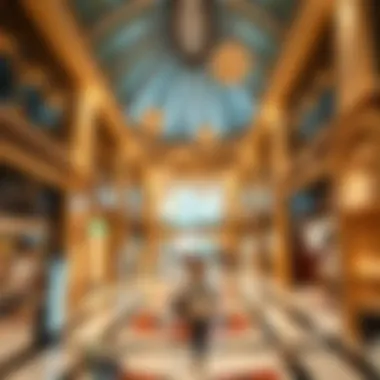

Evolution Over the Decades
As the years rolled on, the evolution of shopping malls in Dubai became a mirror reflecting both the local economy and the aspirations of its residents. The 1990s marked a substantial leap in mall development. With the completion of the Dubai Mall in 2008, the city cemented its position as a global retail giant. The mall, sprawling over 1.1 million square meters, was more than just a shopping venue; it became a destination in its own right. Visitors flocked to see its breathtaking Burj Khalifa views, the magnificent Dubai Aquarium, and various entertainment options.
Malls shifted from merely being places to buy goods to being dynamic environments where lifestyle, culture, and entertainment intertwined seamlessly. This change fostered a sense of belonging and community, especially for expatriates who sought familiar comforts amidst a foreign land. According to recent statistics, around 70% of shoppers in Dubai visit malls at least once a week, underscoring their integral role in daily life.
As shopping malls continue to evolve, they have become key players in Dubai's economy, contributing significantly to tourism and hospitality sectors. The rise of e-commerce created a challenge for physical retail spaces but also encouraged malls to innovate further. Clearly, the journey from their inception to the present day showcases not only the growth of retail options but also the changing habits and expectations of consumers.
"Shopping centers in Dubai aren’t just places to buy; they’ve become vital social and cultural landmarks that contribute to community identity."
Thus, the historical context of malls provides invaluable perspective, revealing how these spaces are not only commercial entities but also vital components of social fabric. Understanding their past is essential for stakeholders and investors seeking to navigate Dubai's retail landscape efficiently.
Key Characteristics of Dubai's Malls
Dubai's malls are more than mere shopping venues; they are vibrant cultural hubs that reflect the city's ethos. This article explores the defining traits that make these spaces integral to Dubai’s urban landscape. Key characteristics not only enhance the shopping experience but also attract tourists, investors, and residents alike, contributing to the city’s economy and social tapestry.
Architectural Innovations
When visiting a mall in Dubai, one can't help but be captivated by stunning architectural designs. The malls embody a fusion of traditional Islamic architecture and modern aesthetics. For instance, the Dubai Mall, with its massive opening and breathtaking views of the Burj Khalifa, exemplifies grandeur at every angle.
Malls like Mall of the Emirates don’t just serve as retail spaces; they showcase cutting-edge design. The incorporation of sustainable materials and energy-efficient technologies are increasingly seen. There’s a growing trend towards a more eco-conscious construction that aligns with global sustainability goals.
Moreover, the layout of these malls is often thoughtfully planned. Wide corridors, stunning atriums, and scenic walkways invite exploration rather than mere shopping. The architectural innovations are not just aesthetic; they create a balanced flow and experience that resonates with both leisurely strollers and serious shoppers. These malls are indeed temples to consumption, but they also embrace the principles of urban design and livability.
Diverse Entertainment Options
One notable feature of Dubai's malls is their broad spectrum of entertainment options. They are not just places to shop but comprehensive leisure destinations. You might find an indoor ski slope at Mall of the Emirates, providing a unique skiing experience in the arid desert. Other malls boast cinemas, aquariums, and even theme parks.
The Dubai Aquarium, located within the Dubai Mall, features one of the world's largest suspended aquariums, fostering an exhilarating and educational experience for families and kids. This blend of shopping and entertainment creates a seamless experience that draws visitors of all ages, making malls the heartbeat of social interaction.
As a result, these malls serve as gathering spots, where community, culture, and commerce intersect. They host numerous events, from seasonal festivals to art exhibitions, expanding their appeal beyond traditional retail.
Luxury Retail Experiences
When it comes to luxury shopping, Dubai excels. The city is home to some of the most exclusive brands available globally, prominently situated in its malls. Fashion Avenue in the Dubai Mall, for instance, features high-end labels like Chanel, Louis Vuitton, and Gucci.
The immersive shopping experiences here often involve personalized services that cater to affluent clientele. Shopping becomes an event, replete with complimentary drinks and private viewings of collections. The ambience of luxury malls is meticulously crafted, enabling shoppers to feel special, enticed, and valued, thus making every visit memorable.
Moreover, the presence of luxury retail in these malls establishes Dubai as a cornerstone of international commerce. With its strategic location, the city attracts shoppers from all over the region wanting to indulge in a lavish experience, adding to the economic importance of these retail palaces.
Major Shopping Malls in Dubai
Dubai's reputation as a global retail hub is largely shaped by its shopping malls. These massive complexes not only serve as commercial centers but also as cultural landmarks that attract millions of visitors each year. The malls in Dubai reflect the city’s wealth and ambition, offering an array of shopping, dining, and entertainment options that appeal to both locals and tourists. Understanding the unique features, visitor dynamics, and economic significance of these malls provides valuable insights into their role within the broader context of Dubai's economy and culture.
The Dubai Mall
Iconic Features
The Dubai Mall is often seen as the crown jewel of shopping malls in the area. It boasts more than 1,200 retail stores and a unique blend of attractions, such as the Burj Khalifa view and the Dubai Aquarium. This mall isn’t just a place to shop; it’s become a destination in itself. One of its hallmark features is the cascading waterfall that greets visitors as they enter—a sight so stunning that it's often captured in photos by countless tourists. The diverse experiences here, from ice skating to virtual reality adventures, make it a beloved choice for families and friends.
Visitor Statistics
When it comes to visitor statistics, the scale of The Dubai Mall is staggering. It attracts over 80 million visitors annually, which is akin to the population of several countries! The consistent high footfall not only signifies its popularity but also underlines its crucial role in promoting tourism in Dubai. Moreover, the mall's location adjacent to the Dubai Fountain and other landmarks makes it easy for visitors to include it in their planned itinerary, thus enhancing its appeal and accessibility.
Economic Impact
The economic impact of The Dubai Mall is profound. It contributes significantly to the local economy by generating revenue through retail sales, dining, and entertainment. Moreover, the job opportunities it creates cannot be overlooked; thousands are employed here, not just in retail settings but also in security, maintenance, and customer service. This creates a substantial ripple effect, benefiting other sectors such as transportation and hospitality. Thus, The Dubai Mall stands as a testament to how retail can drive economic growth in dynamic urban environments.
Mall of the Emirates
Unique Attractions
Mall of the Emirates isn’t just another shopping center; it offers a mix of attractions that you won't find anywhere else. One of the standout features is the indoor ski resort, Ski Egypt, which allows visitors to hit the slopes, regardless of the scorching desert heat outside. This unique blend of activities makes the mall an enticing option not just for shopping, but for a full-day outing.
Skiing Experience


The skiing experience at Mall of the Emirates draws thrill-seekers from all over the globe. It offers a real snow environment, complete with ski slopes, sledding hills, and even penguin encounters. This indoor attraction serves not only as a recreational facility but has also made ski-related merchandise a significant part of the mall's appeal—where else can you ski in the desert? The advantages are clear: it prepares an attractive environment for families, whether they are looking to ski or shop after.
Luxury Shopping
Mall of the Emirates is also synonymous with luxury shopping. Hosting brands such as Chanel and Gucci, it positions itself as a go-to destination for high-end fashion. The mall’s unique characteristic lies in its combination of luxury retail with accessible shopping options. This means consumers can browse premium products while also enjoying more affordable brands. This variety allows a broader audience to experience the exclusivity without breaking the bank.
City Walk
Urban Lifestyle Hub
City Walk presents a different feel from traditional malls. It mixes open-air shopping with street art, making it an urban lifestyle hub that resonates with locals and visitors longing for an immersive experience. The unique element here is the design—rather than being enclosed, the space captures the essence of outdoor markets, encouraging social interaction. This urban aspect significantly enhances the overall shopping experience and attracts a more diverse visitor demographic.
Dining and Leisure
Dining options at City Walk are plentiful and varied; from fine dining to casual eateries, every palate can find something to love. This makes it a popular choice for families and groups. The atmosphere is inviting, fostering leisure and relaxation. The unique blend of taste and aesthetics heightens the dining experience, making it more than just a meal but an event. This not only promotes longer visits but also supports smaller eateries and emerging chefs, further weaving community spirit into the fabric of Dubai.
Art Installations
City Walk takes pride in its art installations, which serve not only as decoration but as meaningful statements reflecting cultural diversity. These artworks add a layer of depth to the shopping experience, making it not just about retail but about appreciating creativity and expression. Visitors often find themselves stopping to admire or photograph these installations, making it a hub for social media engagement as well. This unique feature elevates the mall, promoting engagement and cultural appreciation among the visitors.
Dubai Festival City Mall
Waterfront Attractions
The waterfront attractions of Dubai Festival City Mall are nothing short of spectacular. Set against the beautiful backdrop of Dubai Creek, it offers a charming setting perfect for an enjoyable day out. Visitors can stroll along the waterfront or catch a boat ride by the canal, adding a soothing element to the shopping experience. The scenic ambiance makes it a great spot for family outings, creating memories beyond just shopping.
Family-Friendly Environment
This mall’s family-friendly environment is another strong draw. It provides playgrounds and entertainment options specifically designed for children, allowing families to spend quality time together. Events and activities geared towards kids ensure that families feel welcomed, making it a practical option for parents looking to entertain children while also enjoying shopping and dining. This focus on family needs significantly contributes to the mall's attractiveness for local and expatriate communities alike.
Events and Festivals
Dubai Festival City Mall hosts various events and festivals throughout the year, from cultural celebrations to seasonal festivities. These events create a vibrant community spirit and encourage repeated visits. Each festival typically showcases local culture, emphasizing integration and diversity within shopper experiences. The unique feature of these events is their ability to draw large crowds, fostering community interaction while promoting local talents. This impactful engagement elevates the mall's standing as a cornerstone in Dubai’s bustling social scene.
Economic Importance of Malls
Large shopping malls in Dubai are more than just places for retail therapy; they act as vital cogs in the larger machinery of the local economy. Their significance extends beyond mere consumerism—they generate revenue, facilitate tourism, and create numerous job opportunities. In a rapidly growing city like Dubai, where economic diversification is key, shopping malls play a pivotal role in shaping the economic landscape. This section will delve into two critical aspects of economic importance: the contribution to the local economy and the employment opportunities they provide.
Contribution to Local Economy
When we look at malls, it’s easy to get lost in the dazzling displays and enticing promotions, but their contributions reach far deeper. Shopping malls inject considerable amounts of capital into the local economy. They attract both local residents and international tourists, converting foot traffic into revenue streams. Consider the sheer scale of these structures; they house dozens of stores, eateries, entertainment options, and even hotels. Each of these entities contributes to local taxes and fosters economic growth.
On a broader scale, malls help stimulate ancillary businesses. For instance, a bustling mall will draw nearby restaurants, cafes, and hotels, creating a vibrant ecosystem that promotes further economic activity. According to statistics from the Dubai Economic Department, malls contribute significantly to the emirate's GDP, reflecting the retail sector’s health and robustness.
Additionally, the diverse range of stores helps meet customer needs, making shopping a seamless experience. This not only solidifies the mall's place in the consumer's mind but also reaffirms the destination as a reliable economic hub.
"Shopping malls are not just shopping; they’re a central part of Dubai’s growth narrative."
Employment Opportunities
The presence of large shopping malls correlates directly with job creation. With thousands of employees working across various disciplines, malls serve as significant employment generators. From retail staff and maintenance crews to management and administrative roles, the employment spectrum is vast and varied.
Moreover, many of these positions are entry-level, providing invaluable opportunities for those just entering the workforce. This is particularly relevant for expatriates and local residents alike, as these roles often require varied skill levels.
In recent years, there has also been a push for training and development programs. Malls are increasingly investing in the upskilling of their employees, leading to improved service standards and employee morale. Not only does this benefit the workers, but it enhances customers' experiences, fostering brand loyalty and repeat business.
To summarize, the economic importance of malls in Dubai cannot be overstated. Through their contributions to the local economy and the robust employment opportunities they create, these retail giants enhance both community welfare and financial prosperity. As such, they play an indispensable role in the continued success of Dubai as a premier global destination.
Cultural Impact of Malls in Dubai
Dubai's shopping malls are more than just a place to buy goods—they act as the very fabric weaving diverse communities together. The importance of this topic within the article lies in its exploration of how these commercial hubs influence social dynamics and cultural norms. Understanding the cultural impact of malls helps illuminate their role beyond mere retail outlets, highlighting their contributions as social spaces and melting pots of varied cultures.
Social Hubs for Communities
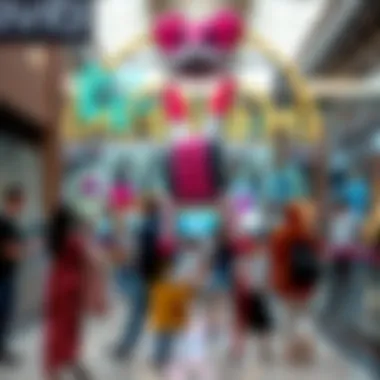

Shopping malls in Dubai are often considered social epicenters, drawing in locals and tourists alike. These spaces facilitate bonding over shared experiences, creating a sense of community. For instance, families often flock to places like The Dubai Mall or Mall of the Emirates to enjoy not only shopping but also entertainment options like cinemas, play areas for children, and even art exhibitions.
- Events and Activities: Malls frequently host events—from seasonal festivals to art shows, fashion displays, and cultural celebrations. Such initiatives serve to engage the community, encouraging participation and interaction among various groups.
- Meeting Points: Coincidentally, these malls provide a convenient meeting point for people. Whether for casual get-togethers or formal meetings, the ambiance of a mall often draws individuals seeking to socialize in a lively setting.
- Diverse Demographics: The multicultural aspect of Dubai means that the social fabric of its malls reflects the city's demographic blend. Malls serve as venues where people from diverse backgrounds interact, promoting broader cultural exchange and understanding.
Integration of Multicultural Elements
Dubai stands as a beacon of multiculturalism, and its malls perfectly embody this ethos. Each mall not only showcases luxury brands but also features a rich tapestry of cultural elements that appeal to a wide audience.
- Culinary Diversity: Food courts and restaurants within malls often serve a wide array of cuisines that cater to the palates of the city’s expatriates and tourists. Here, you can find everything from Emirati favorites to Indian curries, American diners, and Asian-inspired eats—all within a few steps.
- Cultural Celebrations: Malls actively engage in celebrating various cultural festivities, such as Diwali, Eid, and Christmas, showcasing cultural shows that honor local traditions as well as those from the expat communities. This integration encourages mutual respect and appreciation.
- Art and Installations: Significant art installations and exhibitions displayed in malls, sometimes by international artists, create an atmosphere that cultivates art appreciation while reflecting global themes. Such features contribute to a dynamic cultural scene and enhance the visual environment of these spaces.
In summary, the cultural impact of malls in Dubai is substantial. They serve as vibrant social hubs that foster community bonding and intercultural dialogue, enriching the overall experience of residents and visitors alike.
Future Trends in the Mall Sector
Large shopping malls in Dubai aren't just a collection of shops; they are evolving into multi-faceted hubs that reflect changing consumer behaviors and environmental priorities. As we look to the horizon, the future of these retail giants is shaped by sustainability initiatives and technological advancements that promise not only to enhance the shopping experience but also to align with global ambitions for a greener planet.
Sustainability Initiatives
The growing trend of sustainability is increasingly infiltrating the mall sector in Dubai. Shopping centers are not just places to shop; they are becoming crucial players in the quest for environmentally-friendly practices. Here are a few notable initiatives:
- Eco-Friendly Architecture: Developers are incorporating energy-efficient designs, such as natural lighting, green roofs, and solar panels. These strategies help in minimizing carbon footprints.
- Waste Reduction Programs: Malls are implementing recycling programs and composting initiatives to manage waste more effectively. For instance, Dubai Mall has made strides in reducing single-use plastics by encouraging shoppers to opt for sustainable alternatives.
- Sustainable Transportation: To tackle urban congestion, many malls are investing in their own transportation systems or partnerships with ride-sharing services, promoting eco-friendly commuting options for visitors.
These initiatives not only elevate a mall's reputation but also enhance its appeal to a growing demographic of environmentally-conscious consumers. Thus, sustainability is becoming a core foundation for future mall projects, transforming them into eco-friendly marketplaces that attract and retain visitors.
Technological Advancements
The digital age is reshaping how we interact with malls, and Dubai's retail sector is at the forefront of these changes. Technology is being woven into the fabric of shopping experiences, facilitating smoother interactions between consumers and retailers. Let’s explore some key technological trends:
- Smart Technologies: The integration of IoT devices allows for personalized shopping experiences. For instance, potential customers can receive tailored deals directly to their smartphones as they walk through a mall, enhancing engagement.
- Augmented Reality (AR): Malls are implementing AR to create immersive shopping experiences. Shoppers can visualize products in their own homes before making a purchase, which can significantly bridge the gap between physical and online shopping experiences.
- Mobile Payment Solutions: The rise of contactless payments and mobile wallets is reshaping the checkout process in malls, making it quicker and more often preferred by tech-savvy consumers.
By embracing these technological advancements, malls in Dubai stand to improve operational efficiencies and enhance customer satisfaction. With consumers increasingly drawn to convenience and personalization, these trends represent not just temporary shifts but fundamental changes in retail dynamics.
In the rapidly evolving retail landscape of Dubai, the future of malls lies in their ability to blend sustainability with cutting-edge technology.
As we move forward, these trends will not just influence shopping behaviors but will re-define the very essence of what a shopping mall represents.
Closure
The presence of large shopping malls in Dubai is far more than a mere commercial endeavor; it represents a crucial pillar within the social, cultural, and economic framework of the city. As we have explored throughout this article, these vast retail spaces are not just about shopping; they serve as gathering points where diverse cultures converge, creating a unique blend of experiences that resonate with locals and visitors alike.
Economic Significance
From the perspective of sustainability, the malls contribute significantly to the local economy, generating jobs, boosting tourism, and supporting ancillary businesses such as dining and entertainment. The wealth of employment opportunities spurred by these malls empowers residents, offering pathways to careers and livelihoods across various sectors. Larger entities often find that a high footfall translates directly into profitability, thereby ensuring that the economic effects reverberate well beyond the retail landscape itself.
Cultural Importance
Additionally, the malls are instrumental in shaping Dubai's identity. They reflect the aspirations and lifestyles of its residents, becoming stages for cultural activities and events that encourage social interaction among diverse groups. In doing so, they effectively integrate multicultural elements into their fabric, fostering an environment of acceptance and shared experiences, which is critical in a rapidly globalizing world.
Future Prospects
As we gaze into the future of the mall sector, trends such as sustainability initiatives and technological advancements are set to redefine the shopping experience. Investors and property seekers will find that an understanding of these trends, and how they interact with current economic and cultural frameworks, is paramount in navigating this vibrant market.
In summary, large shopping malls in Dubai play an irreplaceable role—a convergence of commerce, culture, and community—offering insights and growth opportunities for all stakeholders involved. For anyone looking to gain a foothold or expand their presence in Dubai's dynamic landscape, recognizing the multifaceted significance of these retail giants is not just beneficial; it is essential.
"Understanding the evolving role of malls in society can illuminate pathways to innovative investment and community engagement."
For further information about the intricacies of Dubai's retail environment, resources like Wikipedia and Britannica provide considerable context.
Importance of References
- Credibility of Information: High-quality references bolster the trustworthiness of the claims made throughout the piece. Investors, homeowners, and expatriates often seek information that is backed by data and research. This fosters an environment of informed decision-making.
- Contextual Understanding: By citing works from historians or economic analysts, readers gain a clearer picture of the social and economic implications of shopping malls. It's not just about the present; it's about how these structures have evolved and shaped the local landscape over time.
- Diverse Perspectives: References bring a variety of viewpoints into the mix. Different authors and researchers may focus on various aspects, whether it's architectural styles, consumer behavior, or cultural impacts. This enriches the narrative by weaving together multiple threads of thought.
Key Elements of References
- Academic Journals: Articles from journals like the International Journal of Retail & Distribution Management can provide empirical data on shopping behaviors and trends.
- Government Reports: Documents published by local authorities can give insights into regulatory frameworks affecting the retail environment in Dubai.
- Market Research Reports: Research by firms like Deloitte or McKinsey can shed light on economic impacts and consumer demographics that are critical for potential investors.
- News Articles and Business Magazines: Publications such as Gulf Business or The National often feature stories or interviews related to shopping malls and are essential for current trends and developments.
Benefits of Well-Researched References
- Informed Investment Decisions: For investors eyeing opportunities in Dubai's retail sector, having access to credible data and analyses allows for smarter financial choices.
- Enhanced Knowledge Base: Homeowners and expatriates looking to understand their environment benefit significantly from well-researched content. This equips them with knowledge of local culture and economic factors that influence everyday life.
- Cultural Sensitivity: Malls play a key role in Dubai's multicultural fabric. References that highlight this aspect can aid readers in navigating social interactions within these spaces.
Final Thoughts
Emphasizing the references used in this article underscores the commitment to providing reliable and enriching content. When it comes to navigating the bustling world of Dubai’s shopping malls, having a solid foundation of verified information helps audiences understand not just what these malls represent, but also how they fit into the broader narrative of Dubai's growth and development.
"A well-researched article is not just informative; it is a bridge to understanding the complexities of modern living in a vibrant city like Dubai."
For more information on the role of shopping malls in the economy, consider checking out sources like
Wikipedia - Shopping malls
Retail and Distribution Management Journal
Dubai Economic Department
Deloitte Insights
McKinsey & Company
.









